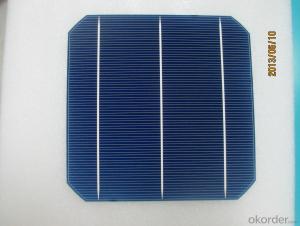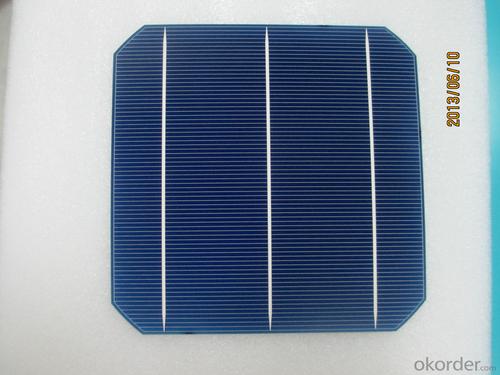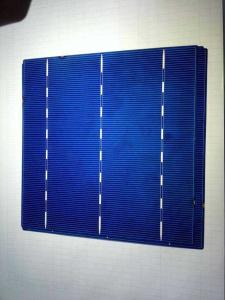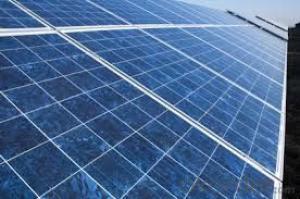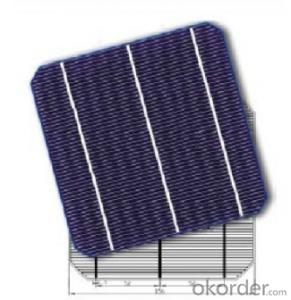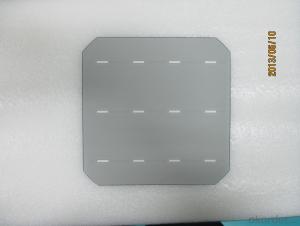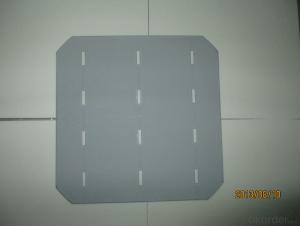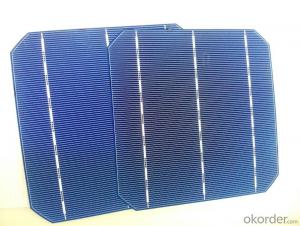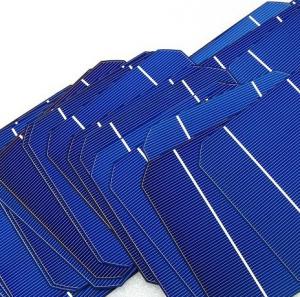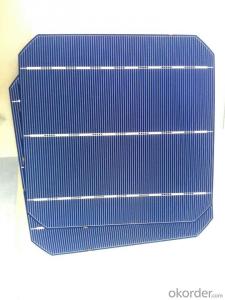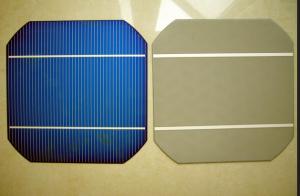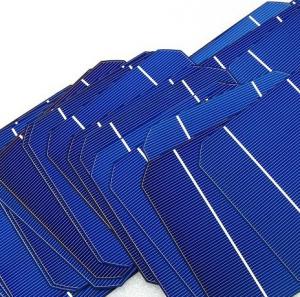Cpv Solar Cells for Sale - Monocrystal Solar Energy Cell 156*156mm Efficiency with Low Price
- Loading Port:
- Tianjin
- Payment Terms:
- TT or LC
- Min Order Qty:
- 10 pc
- Supply Capability:
- 1000000 pc/month
OKorder Service Pledge
OKorder Financial Service
You Might Also Like

Monocrystal Solar Energy Cell
type:156M
appearance:156×1565㎜±0.5mm;diagonal:R=100mm
Main fence wide:1.4-1.5mm back electrode wide:2-2.5mm
Fence line qty:90
Cell thickness:220um±20um
Eff(%) | 18.00- 18.10 | 18.10- 18.20 | 18.20- 18.30 | 18.30- 18.40 | 18.40- 18.50 | 18.50- 18.60 | 18.60- 18.70 | 18.70- 18.80 | 18.80- 18.90 | 18.9- 19.0 | 19.1- 19.1 | 19.1- 19.2 |
Pm(W) | 4.30 | 4.33 | 4.35 | 4.37 | 4.40 | 4.42 | 4.44 | 4.47 | 4.49 | 4.52 | 4.54 | 4.56 |
Isc(A) | 8.71 | 8.73 | 8.76 | 8.77 | 8.78 | 8.82 | 8.83 | 8.85 | 8.86 | 8.88 | 8.9 | 8.93 |
Im(A) | 8.19 | 8.21 | 8.24 | 8.26 | 8.30 | 8.33 | 8.35 | 8.39 | 8.42 | 8.45 | 8.47 | 8.51 |
Voc(V) | 0.630 | 0.631 | 0.632 | 0.633 | 0.634 | 0.634 | 0.635 | 0.636 | 0.637 | 0.637 | 0.638 | 0.64 |
Vm(V) | 0.527 | 0.528 | 0.529 | 0.531 | 0.531 | 0.532 | 0.534 | 0.534 | 0.535 | 0.536 | 0.537 | 0.538 |
FF(%) | 78.6 | 78.7 | 78.8 | 79.0 | 79.2 | 79.3 | 79.5 | 79.6 | 79.8 | 80 | 80 | 80 |

remark:our company cells as per working current concentrate principle,separate the first and the second grade
Factory Picture of Solar Cells
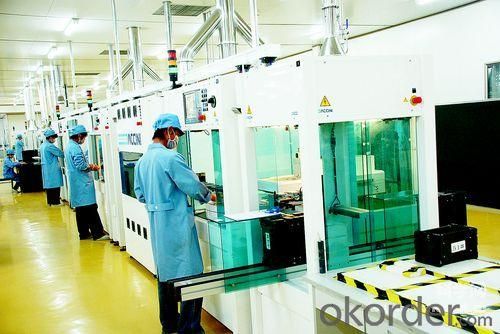
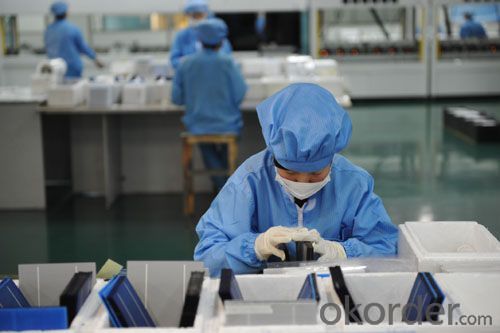
FAQ
We have organized several common questions for our clients,may help you sincerely:
What’s price per watt?
A: It’s depends on the quantity, delivery date and payment terms of the order. We can talk further about the detail price issue. Our products is high quality with lower price level.
Can you tell me the parameter of your solar cells?
We have different series of cells with different power output, both from c-si to a-si. Please take our specification sheet for your reference.
How do you pack your products?
We have rich experience on how to pack the panels to make sure the safety on shipment when it arrives at the destination.
Can you do OEM for us?
Yes, we can.
How long can we receive the product after purchase?
In the purchase of product within three working days, We will arrange the factory delivery as soon as possible. The perfect time of receiving is related to the state and position of customers. Commonly 7 to 10 working days can be served.
Brief introduction of Monocrystal Solar Energy Cell
Silicon rods, materials performance indicators in order to reduce production costs, and now terrestrial applications such as solar cells using solar grade somewhat relaxed. Some also use semiconductor device processing materials and discard the head and tail of silicon materials, solar cells drawn into complex dedicated silicon rods.
The silicon rods cut into pieces, usually 0.3 mm thick sheet. Processing solar cells, the first doping and diffusion in silicon, a trace amount of dopant is generally boron, phosphorus, and antimony. Diffusion is carried out in a quartz tube into a high-temperature diffusion furnace. Thus formed P> N junction on the wafer. Then using a screen printing method, fine with a good paste into a grid line printed on the wafer, after sintering, while forming the back electrode and the surface coated with antireflection gate line source to prevent a large number of photons it is reflected off the smooth surface of the wafer. Thus, the monomer Monocrystal solar energy cells are produced. After single-chip random testing can be assembled according to the required specifications into a solar cell module (solar panel) by the method of series and parallel to a certain output voltage and current.
Difference between Monocrystal Solar Energy Cell and polycrystalline silicon solar panels:
Polycrystalline silicon solar cells and Monocrystal solar energy cells is no different. Life and stability of polycrystalline silicon solar cells and Monocrystal solar energy cells are good. Although the average conversion efficiency of silicon solar cells is higher than the average conversion efficiency of polycrystalline silicon solar cells of about 1%, but because of Monocrystal solar energy cells can be made quasi-square (four to the top of the arc), when the composition of the solar cell module when there is a part of the area filled up, and polycrystalline silicon solar cells are square, there is no problem, so the efficiency of the solar cell module is the same.
In addition, because the manufacturing process two types of solar cell materials is not the same, polycrystalline silicon solar cell manufacturing process energy consumed than Monocrystal solar energy cells is about 30% less.
- Q: What is a monocrystalline solar cell?
- A monocrystalline solar cell is a type of solar cell made from a single crystal structure, usually silicon. It is known for its high efficiency and uniform appearance, as it is made from a single continuous crystal. Monocrystalline solar cells are widely used in solar panels due to their ability to convert sunlight into electricity effectively.
- Q: Can solar cells be used for powering manufacturing facilities?
- Yes, solar cells can be used for powering manufacturing facilities. Solar energy is a renewable and clean source of power that can be harnessed through solar cells, also known as photovoltaic (PV) panels. By installing a sufficient number of solar panels, manufacturing facilities can generate electricity to meet their energy demands. This not only reduces reliance on traditional fossil fuels but also helps in reducing greenhouse gas emissions, making it an environmentally friendly solution for powering manufacturing operations.
- Q: What is the maintenance required for solar cells?
- The maintenance required for solar cells primarily involves periodic cleaning to ensure maximum sunlight absorption, checking for any damage or debris, and monitoring the performance of the system to address any issues promptly. Additionally, regular inspections and maintenance of other components such as inverters, wiring, and batteries may be required to ensure optimal functioning and longevity of the solar cell system.
- Q: Can solar cells be used in boats or marine applications?
- Yes, solar cells can be used in boats or marine applications. Solar panels can be installed on the deck or roof of a boat to harness the power of the sun and convert it into electricity. This electricity can then be used to power various onboard systems such as lights, navigation equipment, communication devices, and even recharge batteries. Solar power offers a sustainable and environmentally-friendly energy solution for boats, reducing reliance on traditional fuel sources and minimizing the carbon footprint of marine activities.
- Q: Can solar cells be used to charge electric vehicles?
- Yes, solar cells can be used to charge electric vehicles. Solar panels can be installed on the roof or other surfaces of an electric vehicle to generate electricity from sunlight. This electricity can then be used to charge the vehicle's battery, providing a renewable and sustainable source of energy.
- Q: Can solar cells be used to power farms or agricultural operations?
- Yes, solar cells can indeed be used to power farms or agricultural operations. Solar panels can be installed on rooftops, open fields, or even integrated into the design of greenhouses to generate clean and renewable energy. This energy can then be used to power various farming operations such as irrigation systems, machinery, lighting, and storage facilities. By utilizing solar power, farmers can reduce their reliance on fossil fuels, lower energy costs, and contribute to a more sustainable and environmentally friendly agricultural sector.
- Q: How much do solar cells cost?
- The cost of solar cells can vary depending on various factors such as the type and size of the solar cell, location, installation costs, and any additional equipment needed. On average, solar cells can range from a few hundred dollars for small, portable units to thousands of dollars for larger, more efficient panels. It is important to consider the long-term savings and benefits of solar energy when evaluating the cost.
- Q: Is A grade better than the B grade when we buy the poly solar cells.
- Poly Solar Cells B Grade might not sound very competitive to the purchasing managers who are purchasing the poly solar cells in the market, but that’s what I need.
- Q: Is the Solar Power Photovoltaic Cells the same as PV cells modules?
- PV modules, using high-efficiency monocrystalline silicon or polycrystalline silicon photovoltaic cells, can actually endure much longer than the other kinds of solar cells even in the most harsh environment.
- Q: How do solar cells perform in regions with high levels of dust and sandstorms?
- Solar cells may experience decreased performance in regions with high levels of dust and sandstorms. The accumulation of dust particles on the surface of solar panels can reduce their efficiency by blocking sunlight and reducing the amount of energy they can generate. Regular cleaning and maintenance of solar panels are essential in such environments to ensure optimal performance. Additionally, advancements in solar panel technology, such as anti-soiling coatings, are being developed to mitigate the impact of dust and sandstorms on solar cell performance.
Send your message to us
Cpv Solar Cells for Sale - Monocrystal Solar Energy Cell 156*156mm Efficiency with Low Price
- Loading Port:
- Tianjin
- Payment Terms:
- TT or LC
- Min Order Qty:
- 10 pc
- Supply Capability:
- 1000000 pc/month
OKorder Service Pledge
OKorder Financial Service
Similar products
Hot products
Hot Searches
Related keywords
